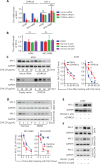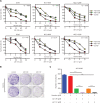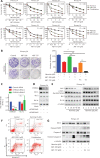DYRK1A suppression restrains Mcl-1 expression and sensitizes NSCLC cells to Bcl-2 inhibitors
- PMID: 32587776
- PMCID: PMC7309455
- DOI: 10.20892/j.issn.2095-3941.2019.0380
DYRK1A suppression restrains Mcl-1 expression and sensitizes NSCLC cells to Bcl-2 inhibitors
Abstract
Objective: Mcl-1 overexpression confers acquired resistance to Bcl-2 inhibitors in non-small cell lung cancer (NSCLC), but no direct Mcl-1 inhibitor is currently available for clinical use. Thus, novel therapeutic strategies are urgently needed to target Mcl-1 and sensitize the anti-NSCLC activity of Bcl-2 inhibitors. Methods: Cell proliferation was measured using sulforhodamine B and colony formation assays, and apoptosis was detected with Annexin V-FITC staining. Gene expression was manipulated using siRNAs and plasmids. Real-time PCR and Western blot were used to measure mRNA and protein levels. Immunoprecipitation and immunofluorescence were used to analyze co-localization of dual specificity tyrosine-phosphorylation-regulated kinase 1A (DYRK1A) and Mcl-1. Results: Suppression of DYRK1A resulted in reduced Mcl-1 expression in NSCLC cells, whereas overexpression of DYRK1A significantly increased Mcl-1 expression. Suppression of DYRK1A did not alter Mcl-1 mRNA levels, but did result in an accelerated degradation of Mcl-1 protein in NSCLC cells. Furthermore, DYRK1A mediated proteasome-dependent degradation of Mcl-1 in NSCLC cells, and DYRK1A co-localized with Mcl-1 in NSCLC cells and was co-expressed with Mcl-1 in tumor samples from lung cancer patients, suggesting that Mcl-1 may be a novel DYRK1A substrate. We showed that combined therapy with harmine and Bcl-2 antagonists significantly inhibited cell proliferation and induced apoptosis in NSCLC cell lines as well as primary NSCLC cells. Conclusions: Mcl-1 is a novel DYRK1A substrate, and the role of DYRK1A in promoting Mcl-1 stability makes it an attractive target for decreasing Bcl-2 inhibitor resistance.
Keywords: Bcl-2 inhibitor; DYRK1A; Mcl-1; NSCLC; combination.
Copyright: © 2020, Cancer Biology & Medicine.
Figures







Similar articles
-
DYRK1A inhibition suppresses STAT3/EGFR/Met signalling and sensitizes EGFR wild-type NSCLC cells to AZD9291.J Cell Mol Med. 2019 Nov;23(11):7427-7437. doi: 10.1111/jcmm.14609. Epub 2019 Aug 27. J Cell Mol Med. 2019. PMID: 31454149 Free PMC article.
-
The Bcl-2/xL inhibitor ABT-263 increases the stability of Mcl-1 mRNA and protein in hepatocellular carcinoma cells.Mol Cancer. 2014 Apr 30;13:98. doi: 10.1186/1476-4598-13-98. Mol Cancer. 2014. PMID: 24779770 Free PMC article.
-
Mcl-1 regulates survival and sensitivity to diverse apoptotic stimuli in human non-small cell lung cancer cells.Cancer Biol Ther. 2005 Mar;4(3):267-76. doi: 10.4161/cbt.4.3.1496. Epub 2005 Mar 20. Cancer Biol Ther. 2005. PMID: 15753661
-
Myeloid cell leukemia 1 (MCL-1): Structural characteristics and application in cancer therapy.Int J Biol Macromol. 2021 Sep 30;187:999-1018. doi: 10.1016/j.ijbiomac.2021.07.166. Epub 2021 Jul 30. Int J Biol Macromol. 2021. PMID: 34339789 Review.
-
DYRK1A inhibitors for disease therapy: Current status and perspectives.Eur J Med Chem. 2022 Feb 5;229:114062. doi: 10.1016/j.ejmech.2021.114062. Epub 2021 Dec 21. Eur J Med Chem. 2022. PMID: 34954592 Review.
Cited by
-
Harmine reinforces the effects of regorafenib on suppressing cell proliferation and inducing apoptosis in liver cancer cells.Exp Ther Med. 2022 Mar;23(3):209. doi: 10.3892/etm.2022.11132. Epub 2022 Jan 7. Exp Ther Med. 2022. PMID: 35126712 Free PMC article.
-
DYRK1A suppression attenuates HIF‑1α accumulation and enhances the anti‑liver cancer effects of regorafenib and sorafenib under hypoxic conditions.Int J Oncol. 2022 Apr;60(4):45. doi: 10.3892/ijo.2022.5335. Epub 2022 Mar 4. Int J Oncol. 2022. PMID: 35244188 Free PMC article.
-
Anti-tumor potential of Harmine and its derivatives: recent trends and advancements.Discov Oncol. 2025 Feb 15;16(1):189. doi: 10.1007/s12672-025-01893-w. Discov Oncol. 2025. PMID: 39954215 Free PMC article. Review.
-
The chromosome 21 kinase DYRK1A: emerging roles in cancer biology and potential as a therapeutic target.Oncogene. 2022 Apr;41(14):2003-2011. doi: 10.1038/s41388-022-02245-6. Epub 2022 Feb 26. Oncogene. 2022. PMID: 35220406 Free PMC article. Review.
-
Erratum to DYRK1A suppression restrains Mcl-1 expression and sensitizes NSCLC cells to Bcl-2 inhibitors.Cancer Biol Med. 2022 May 10;19(7):1109-10. doi: 10.20892/j.issn.2095-3941.2022.0172. Cancer Biol Med. 2022. PMID: 35532134 Free PMC article. No abstract available.
References
-
- Lever JR, Fergason-Cantrell EA. Allosteric modulation of sigma receptors by BH3 mimetics ABT-737, ABT-263 (Navitoclax) and ABT-199 (Venetoclax). Pharmacol Res. 2019;142:87–100. - PubMed
Publication types
MeSH terms
Substances
LinkOut - more resources
Full Text Sources
Medical
Molecular Biology Databases
